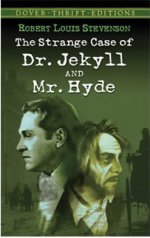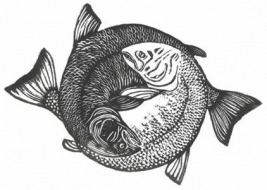The Strange Case of Dr. Jekyll and Mr. Hyde
Meet the Author

Robert Louis Balfour Stevenson was born in Edinburgh, Scotland on November 13th, 1850. His father, Thomas Stevenson, was a leading lighthouse engineer and his mother, Margaret Isabella Balfour, was the daughter of the minister of the Church of Scotland. Robert was a sickly boy who, after contracting tuberculosis, spent much of his childhood confined to his bed. It was then that his creativity at storytelling flourished as he was always creating wild adventures that kept his parents and his nurse, Alison “Cummy” Cunningham amused. Although he was a late reader, first reading at the age of seven or eight, Stevenson had a flair for writing. His first authentic literary work, an account of the covenanter’s rebellion, was published when he was merely sixteen.
Under his father’s footsteps, Robert Stevenson put his writings aside and attended Edinburgh University to become a lighthouse engineer. Unfortunately, the occupation struck him as dreary and against his father’s wishes, he began studying law instead. Stevenson soon got his law degree but never put it to actual use. Instead, he moved to France due to his health and other interests, and began his career as a writer.
At age 26, Stevenson began seeing Fanny Osbourne, a married, American woman who was eleven years older than him. The two got married four years later, after her divorce. After she moved back to California, Stevenson decided to move with her and the two lived in the splendor of their love, although they had only enough money to subsist in modesty. The two, along with Stevenson’s stepson, would often visit his family in Europe. This was the time where most of Stevenson’s popular novels such as Kidnapped, and The Strange Case of Dr. Jekyll and Mr. Hyde became well-known.
After his father’s death, he and his family including his widowed mother sailed to the Pacific Islands where he continued to write and gain fame. The climate proved to be so good for his health that they decided to make their home on the island of Upolu on Samoa. Ironically, even though Stevenson fought so hard for his health and wellbeing, he died only six years after settling on the islands from what is argued to be either a brain hemorrhage or a stroke.
Inspiration: Louis Robert Stevenson was the type of person who would marry an already married older woman, go against his father’s wishes, and leave his homeland to travel all over the world. At the same time, he remained respectful of his parents, kept family bonds intact, and loved his children. Clearly, it was this split personality that was the inspiration for his writing of The Strange Case of Dr. Jekyll and Mr. Hyde. The novel was instantly a success as readers were ensnared by Stevenson’s vivid interpretation of a man corrupted by the duality of human nature.
Under his father’s footsteps, Robert Stevenson put his writings aside and attended Edinburgh University to become a lighthouse engineer. Unfortunately, the occupation struck him as dreary and against his father’s wishes, he began studying law instead. Stevenson soon got his law degree but never put it to actual use. Instead, he moved to France due to his health and other interests, and began his career as a writer.
At age 26, Stevenson began seeing Fanny Osbourne, a married, American woman who was eleven years older than him. The two got married four years later, after her divorce. After she moved back to California, Stevenson decided to move with her and the two lived in the splendor of their love, although they had only enough money to subsist in modesty. The two, along with Stevenson’s stepson, would often visit his family in Europe. This was the time where most of Stevenson’s popular novels such as Kidnapped, and The Strange Case of Dr. Jekyll and Mr. Hyde became well-known.
After his father’s death, he and his family including his widowed mother sailed to the Pacific Islands where he continued to write and gain fame. The climate proved to be so good for his health that they decided to make their home on the island of Upolu on Samoa. Ironically, even though Stevenson fought so hard for his health and wellbeing, he died only six years after settling on the islands from what is argued to be either a brain hemorrhage or a stroke.
Inspiration: Louis Robert Stevenson was the type of person who would marry an already married older woman, go against his father’s wishes, and leave his homeland to travel all over the world. At the same time, he remained respectful of his parents, kept family bonds intact, and loved his children. Clearly, it was this split personality that was the inspiration for his writing of The Strange Case of Dr. Jekyll and Mr. Hyde. The novel was instantly a success as readers were ensnared by Stevenson’s vivid interpretation of a man corrupted by the duality of human nature.
Book Summary:

click here
The story of Dr. Jekyll and Mr. Hyde begins as Mr. Utterson is discussing with his friend about the appearance of a hideous figure by the name of Mr. Hyde that has been seen trampling a little girl. When forced to pay reparations for the crime, Mr. Hyde disappears and returns with a check signed by the respectable Dr. Jekyll. Concerned that Dr. Jekyll’s association with Mr. Hyde may be through blackmail, Mr. Utterson visits Dr. Jekyll who talks him out of his fears, saying that he can be rid of Mr. Hyde whenever he wants to. A year passes uneventfully until one day a young maid witnesses Mr. Hyde beating Sir Danver Carew to death with a cane. When police rush to Hyde’s apartment led by Utterson, only the cane remains. Mr. Utterson makes another visit to Dr. Jekyll who gives him a letter written by Mr. Hyde apologizing for the transgressions that he has made and that he will never be seen again.
Time progresses and Dr. Jekyll, who had seemed to become more lively and vigorous, reverts back to his mysterious ways and even locks himself inside his laboratory. Dr. Jekyll’s fretful servants discuss matters with Mr. Utterson and they resolve to break open the laboratory door. Once inside, they see Mr. Hyde dressed in the oversized attire of Dr. Jekyll as well as a letter addressed to Mr. Utterson from Dr. Jekyll. Upon reading it, Mr. Utterson finally discovers the truth behind puzzling events that have occurred with Dr. Jekyll and Mr. Hyde. It turns out, Dr. Jekyll had always believed in the duality of human nature, and sought to find a way to release the evil self that he has been suppressing throughout his life. Dr. Jekyll was finally successful of concocting a potion that would allow him to do so, and after drinking it, he was transformed into Mr. Hyde. It was then that Dr. Jekyll, under the persona Mr. Hyde, began terrorizing society, with not a trace of remorse until the incident with the trampling of the little girl. Dr. Jekyll tried to stop changing into Mr. Hyde, but was unsuccessful of repressing his desires. After Mr. Hyde beat Sir Danver Carews to death, Dr. Jekyll was finally able to quit taking the potion, but it was already too late. Mr. Hyde began appearing without the use of the potion and Dr. Jekyll.The transformations got more and more frequent and Jekyll eventually needed larger doses of potion to reverse the transformations. With his last reverse-potion, Dr. Jekyll perseveres long enough to write the letters to Mr. Utterson.
Time progresses and Dr. Jekyll, who had seemed to become more lively and vigorous, reverts back to his mysterious ways and even locks himself inside his laboratory. Dr. Jekyll’s fretful servants discuss matters with Mr. Utterson and they resolve to break open the laboratory door. Once inside, they see Mr. Hyde dressed in the oversized attire of Dr. Jekyll as well as a letter addressed to Mr. Utterson from Dr. Jekyll. Upon reading it, Mr. Utterson finally discovers the truth behind puzzling events that have occurred with Dr. Jekyll and Mr. Hyde. It turns out, Dr. Jekyll had always believed in the duality of human nature, and sought to find a way to release the evil self that he has been suppressing throughout his life. Dr. Jekyll was finally successful of concocting a potion that would allow him to do so, and after drinking it, he was transformed into Mr. Hyde. It was then that Dr. Jekyll, under the persona Mr. Hyde, began terrorizing society, with not a trace of remorse until the incident with the trampling of the little girl. Dr. Jekyll tried to stop changing into Mr. Hyde, but was unsuccessful of repressing his desires. After Mr. Hyde beat Sir Danver Carews to death, Dr. Jekyll was finally able to quit taking the potion, but it was already too late. Mr. Hyde began appearing without the use of the potion and Dr. Jekyll.The transformations got more and more frequent and Jekyll eventually needed larger doses of potion to reverse the transformations. With his last reverse-potion, Dr. Jekyll perseveres long enough to write the letters to Mr. Utterson.
Themes

The duality of human nature has always been a highly regarded theme in literature. It is much more frequently portrayed through two different characters whose traits contrast from each other’s, but the story of Dr. Jekyll and Mr. Hyde is unique because it shows a single individual reflecting both extremes of human behavior. In the novel, Stevenson is able to show that even with the most virtuous of men, there is still a hidden evil lurking from within, and that both personality extremes have an equal ability to be expressed if given the chance.
Another important theme found within the novel is of how a scholar's search for hidden knowledge is usually met by many challenges and limitations. Before him, nobody had even dared to consider that possibility of physically separating the two different natures of a human being. Dr. Jekyll is a strong example of a scientist who dared to do and learn more than what a man should, and because of that, he sacrifices his own life as well as the lives of others in the process.
Another important theme found within the novel is of how a scholar's search for hidden knowledge is usually met by many challenges and limitations. Before him, nobody had even dared to consider that possibility of physically separating the two different natures of a human being. Dr. Jekyll is a strong example of a scientist who dared to do and learn more than what a man should, and because of that, he sacrifices his own life as well as the lives of others in the process.
Science and Profit

In the case of Dr. Jekyll, his scientific pursuits were not instigated by greed, but rather a desire to discover something never before seen in the field of science. There was no monetary price put on Dr. Jekyll’s findings, and even though he was a wealthy man, the only type of actual profit that Jekyll was looking for was the profit of being able to set free his restraints while still upholding his sophisticated façade. Let’s not forget that Dr. Jekyll is a well-respected gentleman, and to have him spontaneously wreak havoc on society would not be good for his image. Dr. Jekyll's ordeal is unique in comparison to the rest of the scientists because it is clear that his experiment caused him to lose a lot of money, and he did not seem to mind. After, Dr. Jekyll, while under the identity of his evil persona, Mr. Hyde, violently beat a young girl early in the book, he freely hands the people a check to pay for all of his damages. Also, the ingredients required to concoct the potion itself were very expensive, yet he continued to purchase them until he could not afford any more.
